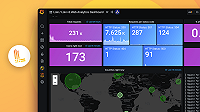Manage authentication
Grafana Loki does not come with any included authentication layer. You must run an authenticating reverse proxy in front of your services.
The simple scalable and microservices deployment modes require a reverse proxy to be deployed in front of Loki, to direct client API requests to the various components.
By default the Loki Helm chart includes a default reverse proxy configuration, using an nginx container to handle routing traffic and authorization.
A list of open-source reverse proxies you can use:
- HAProxy
- nginx using their guide on restricting access with HTTP basic authentication
- OAuth2 proxy
- Pomerium, which has a guide for securing Grafana
Note
When using Loki in multi-tenant mode, Loki requires the HTTP header
X-Scope-OrgIDto be set to a string identifying the tenant; the responsibility of populating this value should be handled by the authenticating reverse proxy. For more information, read the multi-tenancy documentation.
For information on authenticating Promtail, see the documentation for how to configure Promtail.
Enable basic authentication for Loki using nginx
This section describes the process of enabling basic authentication for Loki using nginx.
Prerequisites
- A running Loki instance
- A running nginx instance
Configure nginx
You must create a new nginx configuration file for the Loki instance.
This example assumes the following:
- nginx is running in
/opt/homebrew - Loki is running on port 3100 on the local machine
- Your Loki tenant id is
fake - The configuration file is named
/opt/homebrew/etc/nginx/loki.conf
If you used different configuration parameters for Loki, adjust the examples to match your configuration.
loki.conf configuration:
upstream loki {
server 127.0.0.1:3100;
keepalive 15;
}
server {
listen 80;
server_name loki.localhost;
auth_basic "loki auth";
auth_basic_user_file /opt/homebrew/etc/nginx/passwords;
location / {
proxy_read_timeout 1800s;
proxy_connect_timeout 1600s;
proxy_pass http://loki;
proxy_http_version 1.1;
proxy_set_header Upgrade $http_upgrade;
proxy_set_header Connection "Keep-Alive";
proxy_set_header Proxy-Connection "Keep-Alive";
proxy_redirect off;
}
location /ready {
proxy_pass http://loki;
proxy_http_version 1.1;
proxy_set_header Connection "Keep-Alive";
proxy_set_header Proxy-Connection "Keep-Alive";
proxy_redirect off;
auth_basic "off";
}
}This configuration must be included in your main nginx configuration, for example, by including it in nginx.conf like:
include /opt/homebrew/etc/nginx/loki.conf;Restart the nginx server to ensure all configuration changes are updated.
Validate your nginx configuration
To validate the nginx configuration for Loki, you can send a curl request to two endpoints:
- The
/readyendpoint, which is not protected by a basic authentication mechanism.
% curl -i http://loki.localhost/ready
HTTP/1.1 200 OK
Server: nginx/1.29.2
Date: Thu, 16 Oct 2025 14:28:31 GMT
Content-Type: text/plain; charset=utf-8
Content-Length: 6
Connection: keep-alive
X-Content-Type-Options: nosniff
ready- The
/endpoint, which is protected by a basic authentication mechanism.
curl -i http://loki.localhost/
HTTP/1.1 401 Unauthorized
Server: nginx/1.29.2
Date: Thu, 16 Oct 2025 14:32:43 GMT
Content-Type: text/html
Content-Length: 179
Connection: keep-alive
WWW-Authenticate: Basic realm="loki auth"
<html>
<head><title>401 Authorization Required</title></head>
<body>
<center><h1>401 Authorization Required</h1></center>
<hr><center>nginx/1.29.2</center>
</body>
</html>Update passwords
The password file can be seeded using whatever mechanism you may use for other web services.
In this example, htpasswd is utilized:
% htpasswd -c /opt/homebrew/etc/nginx/passwords loki123
New password:
Re-type new password:
Adding password for user loki123Restart the nginx server to ensure all configuration changes are updated.
Validate passwords
Enter your password into a temporary file, such as:
% vi lokipwThen, store it as an environment variable::
% pass=$(cat lokipw)You can validate basic authentication is then working by issuing a curl command to the protected resource:
curl -i -u loki123:$pass -H "X-Scope-OrgID:fake" "http://loki.localhost/loki/api/v1/labels"
HTTP/1.1 200 OK
Server: nginx/1.29.2
Date: Thu, 16 Oct 2025 14:46:09 GMT
Content-Type: application/json; charset=UTF-8
Content-Length: 21
Connection: keep-alive
{"status":"success"}


